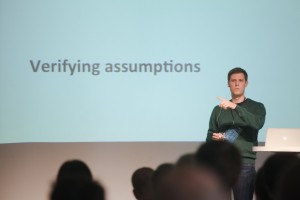
The Circle of Assumptions
When discussing an issue or solving a problem, people often jump to conclusions before they spend time talking about what the problem is – or what data they have at hand. The Circle of Assumptions teaches us an orderly way to think about problems, starting with data and building toward conclusions.
It enables us to see how easily our communication can be garbled by our failure to be aware of our own assumptions – and how they affect the conclusions we reach.
The Circle of Assumptions
| Ring | Definition |
Example |
| Data | Observable data and experiences, as a camera might record them. | “We are planning to launch a new product.” |
| Interpretations | Data we select from what we observe, often based on our own belief system. | “Once again we’re behind schedule.” |
| Evaluations | Value judgments and meanings that we add, often laden with emotion. Words like “right” and “wrong” or “good” and “bad” creep into our language. | “This is their fault.” |
| Conclusions | Statements that indicate our mind is made up. Over time, our conclusions become the basis for our beliefs. | “We need a better team.” |
| Actions | Steps taken. | “I’m going to tell my boss.” |
Here’s an example of a typical assumption at work:
Your boss is leading a discussion of the launch of a new software product in 12 weeks. He’s laying out the production schedule. A co-worker says, “If the launch is in 12 weeks, then we’re already two weeks behind schedule.”
Immediately, your mind draws the following conclusions:
- “Once again we’re behind schedule. Why do we always make this mistake?”
- “This is my boss’s fault. He should have seen this coming. I’m not going to take part in a project that’s bound to fail.”
At that moment, your boss pulls out a project schedule and says: “It’s funny. I anticipated your question. And if you look at our schedule, you’ll see we’re exactly where we planned to be. Because of our new supplier, we can get the product in stores in less than eight weeks. We’re actually one week ahead of schedule.”
As your co-worker turns red, you thank your lucky stars that you kept your assumptions to yourself!
Clarifying People’s Assumptions
Psychologists know that people’s beliefs affect how they interpret data. So the Circle of Assumptions teaches us that people can get caught in self-justifying feedback loops, where they become blind to data which does not reinforce their beliefs.
A critical element of productive conversation is the ability to assess what people really know, and what they think they know. The Circle of Assumptions teaches us to drive back toward the center, toward the data, and to keep checking each other’s assumptions. People need to ask:
- “What are your assumptions?”
- “What assumptions do you think we are (or I am) making?”
- “What’s the data for that?”
- “What am I (are we) missing here?”
Skillful communicators frequently probe their own assumptions and challenge them.
This sets the stage for other people to do the same. When people focus on the data that they’re missing, it allows them to move forward to resolve the problem rather than remaining mired in their assumptions.
- “Here are the assumptions I’m making. Please feel free to challenge them.”
- “I want to make sure we’re thinking clearly here. What data could we be missing? What assumptions are we making?”
- “I’m concerned that we may be assuming too much. Let’s start with what we actually know.”
- “What data, if we had it in our hands right now, would change our thinking about this issue?”
Keep the concept of being data-driven in mind.
The Assumption of Competence
Adding a further layer of complexity is the fact that our brains are hard-wired with what psychologists call “the assumption of competence.” In essence, we perceive ourselves – and want to be perceived by others – as competent and infallible, not prone to error.
The assumption of competence is a well-known psychological syndrome that boosts our image of ourselves as competent and in control. It is thought that it played an ancient role in our survival by helping early human beings feel in control – despite overwhelming odds. Today, it drives much of how we behave. For example, it can result in self-justifying feedback loops, where people become anchored in their position, blind to data that does not reinforce their conclusions.
We unconsciously tend to assume we know more than we do, or that we have more power than we do.
The Assumption of Competence affects all of our communication and decision-making. Consider the following types of activities:
- A management team is examining strategic options. The CEO says, “It all boils down to the marketplace. If our competitor cuts his prices $1, then we’ll do the same. It’s as simple as that.” (In this case, the assumption of competence is that the CEO has the ability to respond to any price change. A second assumption is that pricing is the most important market driver, and that pricing flexibility is thus the only scenario to examine.)
- A manager is giving an employee her annual review, “I know you want a higher-paying position with our company, but we don’t have any openings now.” (In this case, the assumption of competence is that it’s good management to limit the conversation to an assessment of the situation, rather than explore the employee’s aspirations and discuss what the company can do to help her realize them.)
- A group of people is developing options for a new product. The team leader says, “We’ve got the best minds we need in the room, right here. Let’s hear your best ideas. From there, we’ll develop a plan.” (In this case, the leader extends his assumption of competence to include everyone in the group. In an effort to make everyone feel valued, he loses an opportunity to begin by saying: “We want to get all the possibilities are on the table. Who else should we canvass
Summary
To communicate productively, a group has to be able to challenge its members’ assumptions.
The most important assumptions to examine are always the ones that people cling to most dearly. Often these assumptions are based on deeply held beliefs. Unmasking these beliefs and assumptions helps us learn and understand what motivates us – and raise the level of group discussion and decision-making.
From a management perspective, this is a skill we need to model ourselves before we can ask it of others. By inviting other people to test our assumptions, we set an example we can then use in our communications with them.
Note: People who want to learn more about the Circle of Assumptions may want to purchase a copy of the book “Straight Talk: Turning Communication Upside Down for Strategic Results at Work.”







[…] Lesson 13: The Circle of Assumptions […]
[…] points of view, and then inject inquiry to bring the conversation back toward the center of the Circle of Assumptions, back toward the […]
[…] got to be simultaneously listening to her arguments and asking yourself, “Where is she on the Circle of Assumptions? What data is she missing? What’s going on in her Inner Script?” Everyone in the room should be […]
[…] Ask questions… If someone says ‘They are X’, then ask them what X means to them, if they can show an example, if they can come with an example of the reverse either in the same situation or in another situation. Does it mean the same to you and the other listeners?. Ask ‘why’ – why does the commentator think that ‘They are X’, what assumptions do they base it on. Ask what they would propose to ‘do about it’ and brainstorm how their proposals could cause harm and benefit? Ask ‘who’ – who in particular are they talking about, what are the specific situations of whom they are taking about, to what extent can they justify generalising that instance to the many. Then lastly ask if they really think what they say, that ‘They are X’ or if ‘They are doing X sometimes and sometimes does Y’. […]
[…] leaders help people see the implications of the “assumption of competence.” They train themselves and others to question their assumptions and to keep an open mind. In so […]
[…] before they spend time talking about what the problem is – or what data they have at hand. The Circle of Assumptions teaches us an orderly way to think about problems, starting with data and building toward […]
[…] next tool is directly related to the Circle of Assumptions: Invite inquiry into your views. The purpose of this tool is to help push ourselves closer toward […]
[…] people get into conflicts in the first place. People naturally gravitate to the outer rings of the Circle of Assumptions. This is especially the case when they’re under duress or feeling […]
[…] The Circle of Assumptions […]